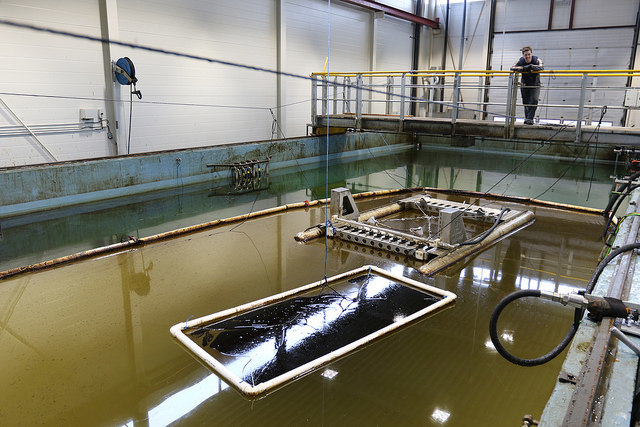
Norwegian scientists are close to establishing whether water can replace chemicals in cleaning up oil slicks.
Tests at the Norwegian Horten centre have been putting a boom that throws up a spray of water and oil through its paces.
The tests have been coordinated by the Norwegian Coastal Administration.
The technology is being led by the NCA and the Norwegian Clean Seas Association for Operating Companies (Nofo).
The two organisations have invited Norwegian and international companies to propose new or improved clean-up methods for oil spills.
The NCA’s Hanne Solem Holt is the principal engineer helping to ensure that this innovative concept for mechanical dispersion can be tested.
“We don’t have dispersion equipment among our emergency response materials today, but it’s very interesting to see new hardware opportunities,” she said
The aluminium rig in the pool is equipped with high-pressure nozzles which spray out water to make an oil slick break up into smaller droplets. These remain suspended in the water column and can be decomposed by bacterial action.
This approach is largely used already by offshore players, but with the aid of chemicals. Replacing these additives by water is intended to have the same effect.
The rig was invented by Stein Erik Sørstrøm from Norway’s Sintef research foundation.
“This is the most realistic test we’ve conducted with this rig,” explains Sørstrøm.
“It’s been tried out earlier with oil on a small scale at Sintef and on a larger scale but without oil at the Marintek research centre.
“The present trial is important for acquiring all the information we need – for obtaining the final answer. We’re starting to get close now,” he added.
The challenge is to achieve sufficient energy when the water spray hits the oil spill with a number of sprayers needed to cover a slick.
“We’ve now tested how far apart it’s possible to position the nozzles, and how quickly we can run the rig over a slick,” he says.
Sørstrøm and his colleagues will use the test results from Horten to adjust the solution before it undergoes final verification under realistic ocean conditions.